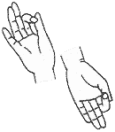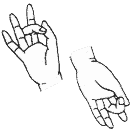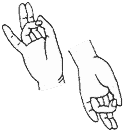By Mark Schumacher
In Buddhist sculpture and painting throughout Asia, the Buddha (Nyorai, Tathagata) are generally depicted with a characteristic hand gesture known as a mudra. Mudras are used primarily to indicate the nature and function of the deity. They are also used routinely by current-day Japanese monks in their spiritual exercises and worship.
One of the easiest and understandable ways to talk about mudras is to focus on AMIDA BUDDHA, who is the savior of the Pure Land School (Jodo and Jodo Shinshu), which happens to be one of Japan’s largest denominations.
Nine Levels of Rebirth in Amida’s Pure Land
Amida’s Pure Land is composed of nine different levels or grades, and devotees are reborn into one of the nine after death. In Japan, the nine levels are sometimes represented in Amida paintings and sculpture by nine different mudras.
| Upper Grade Jōshō 上生 |
Upper, Upper Birth Jōbon Jōshō 上品上生 |
 Upper, Middle Birth Chūbon Jōshō 中品上生 |
 Upper, Lower Birth Gebon Jōshō 下品上生 |
|
|
|
||||
| Middle Grade Chūshō 中生 |
Middle, Upper Birth Jōbon Chūshō 上品中生 |
 Middle, Middle Birth Chūbon Chūshō 中品中生 |
 Middle, Lower Birth Gebon Chūshō 下品中生 |
|
|
|
||||
| Lower Grade Geshō 下生 |
Lower, Upper Birth Jōbon Geshō 上品下生 |
 Lower, Middle Birth Chūbon Geshō 中品下生 |
 Lower, Lower Birth Gebon Geshō 下品下生 |
|
Please visit Mark Schumacher’s site for in-depth discussions about mudras, Buddhism and related subjects at http://www.onmarkproductions.com/html/buddhism.shtml

Comments